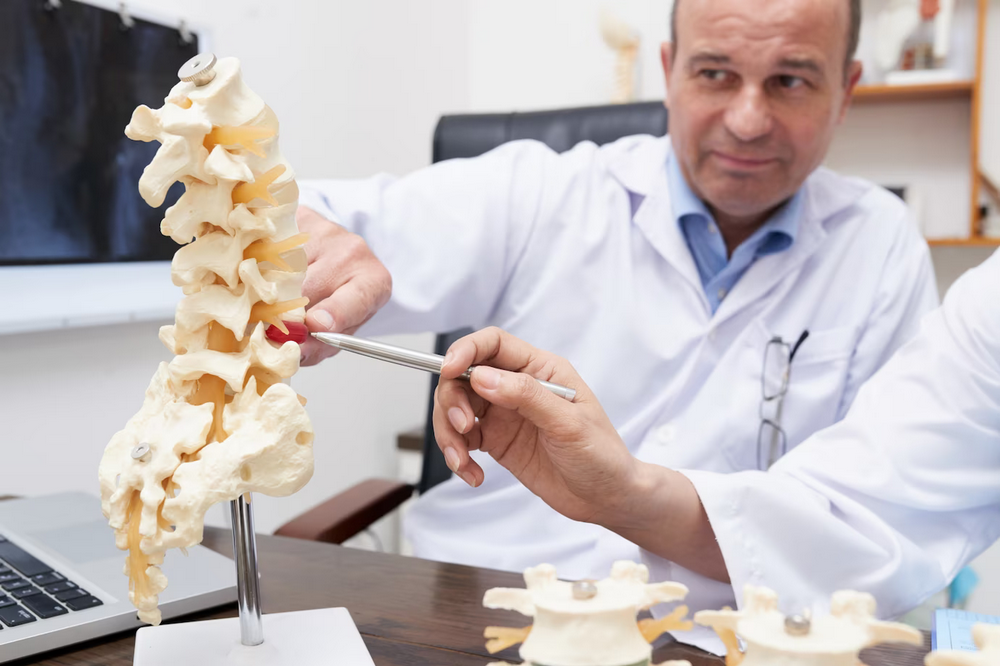Spinal cord injuries are a serious medical condition with life-altering consequences. Depending on the severity of the injury, treatment can vary significantly. This section will cover the different types of spinal cord injuries, immediate treatment options, surgical methods, medications, rehabilitation, and living with a spinal cord injury.
It is important to understand the different types of spinal cord injuries, as the severity of the injury will dictate the type of treatment needed for a successful recovery.
The most common type of spinal cord injury is a complete spinal cord injury, which is characterized by total loss of sensation and movement below the injury site.
In contrast, an incomplete spinal cord injury still allows for partial movement and sensation below the injury site.
Both types of spinal cord injuries require specialized medical care, and this article will explore the various treatments available.
Types of Spinal Cord Injury
Spinal cord injury is a complex medical condition that can vary in severity and type.
Generally, spinal cord injuries can be divided into two main categories: complete and incomplete, and further into cervical, thoracic, and lumbar injuries.
The severity of a spinal cord injury is assessed by the level of paralysis and includes paraplegia and tetraplegia.
Complete vs. Incomplete Spinal Cord Injury
The severity of an auto accident victim’s condition can be determined by assessing the degree of impairment in the function of the affected region of the body and determining whether the injury is a complete or incomplete spinal injury.
A complete spinal cord injury (SCI) is a trauma that completely severs the spinal cord, causing complete loss of function and sensation below the level of injury.
In contrast, an incomplete spinal cord injury is defined as a trauma that does not completely sever the spinal cord, allowing for some preservation of function and sensation below the level of injury.
The level of a spinal cord injury is determined by the affected area of the spinal cord, which is typically designated by a letter-number combination.
Complete SCI will usually result in paralysis, loss of sensation, and loss of reflexes below the level of injury.
In contrast, incomplete SCI may result in only partial paralysis and loss of sensation.
Treatment of spinal cord injuries includes physical therapy, occupational therapy, and medications to help reduce pain and swelling, as well as to promote healing.
Surgery may also be needed to stabilize the spine and to correct any deformities that may have resulted from the injury.
Cervical, Thoracic, and Lumbar Injuries
Injuries to the spinal column can be further categorized according to their location along the cervical, thoracic, or lumbar regions.
Cervical spinal cord injuries occur most commonly from motor vehicle accidents and occur in the neck region.
Cervical injuries can be complete or incomplete, with complete injuries resulting in paralysis of both arms and legs.
Thoracic injuries are less common than cervical injuries, but can still cause significant paralysis depending on the area and severity of the injury.
Lumbar injuries occur in the lower back region and are less severe than cervical or thoracic injuries, but can still result in significant paralysis.
Treating a spinal cord injury depends on the location and severity of the injury.
In general, physical therapy, medications, and bracing can be used to treat spinal cord injuries.
In addition, surgery may be necessary in order to stabilize the spine or repair any damage to the vertebrae.
It is important to seek immediate medical attention for any suspected spinal cord injury, as early intervention can improve the outcome for the patient.

Severity Levels: Paraplegia and Tetraplegia
Paraplegia and tetraplegia are two distinct levels of severity for spinal cord injuries, with paraplegia resulting in partial paralysis of the lower body and tetraplegia resulting in paralysis of the arms and legs.
Paraplegia is a less severe form of spinal cord injury, typically resulting in paralysis of the lower body, including the legs and hips, but leaving the arms and hands intact. Symptoms of paraplegia can range from decreased sensation and muscle weakness to complete loss of feeling and movement. Paraplegia may also cause a loss of bladder and bowel control, as well as loss of body temperature regulation.
Tetraplegia, on the other hand, is a more severe form of paralysis, typically resulting in paralysis of all four limbs. Symptoms of tetraplegia can range from loss of sensation and movement to complete loss of feeling and movement. Tetraplegia may also cause loss of bladder and bowel control, as well as loss of body temperature regulation.
Treatment for paraplegia and tetraplegia may include physical therapy, medications, surgery, and other forms of medical interventions.
Immediate Treatment
Immediate medical attention is essential in the event of a motor vehicle accident, as the severity of potential injuries could significantly impact long-term recovery.
Spinal cord injury is one of the most serious injuries that can occur, and it is important to understand the different treatment options that are available.
Spinal cord injury patients often require intensive medical care and rehabilitation to help them to recover from their injuries.
Immediate treatment for spinal cord injuries can involve stabilizing the patient and preventing further injury, as well as providing pain relief and controlling inflammation. This can include medications, immobilization, and other interventions.
After stabilization, the focus shifts to rehabilitation, which can include physical therapy, occupational therapy, and other therapies that are designed to help the patient regain their abilities and mobility.
Surgery may also be necessary to repair the damage caused by the injury.
It is important to seek appropriate medical attention quickly in order to ensure the best outcome for the patient.
Surgery
When treating a spinal cord injury, surgery can be a critical component of the recovery process. Following an initial assessment of the injury, a medical professional may opt for surgical intervention to help the patient heal.
This type of treatment can help reduce inflammation and relieve pressure on the spinal cord, allowing for the potential for improved patient outcomes.
Surgery for spinal cord injuries may involve one or more of the following techniques:
- Fusion: Involves joining two or more vertebrae together to provide stability and reduce pain.
- Discectomy: Removal of all or part of a damaged or herniated disc.
- Vertebroplasty: Involves injecting a cement-like material into a fractured vertebra to provide stability and reduce pain.
- Decompression: Involves removing any material that is pressing on the spinal cord, such as tumors or bone fragments.
Medication for Spinal Cord Injury
Medication may be prescribed as part of an overall treatment plan for spinal cord injuries, with the aim of reducing inflammation, relieving pain, and improving patient outcomes. The types of medications used for spinal cord injury treatment vary depending on the type of injury and the symptoms the patient is experiencing. Common medications used to treat spinal cord injuries include anti-inflammatory drugs, corticosteroids, muscle relaxants, and pain medications. In some cases, antidepressants or anticonvulsants may also be prescribed.
| Medication | Purpose |
| Anti-inflammatory Drugs | Reducing Inflammation |
| Corticosteroids | Reducing Inflammation |
| Muscle Relaxants | Reducing Muscle Spasms |
| Pain Medications | Relieving Pain |
| Antidepressants | Improving Mood |
| Anticonvulsants | Reducing Seizures |
Rehabilitation
Rehabilitation for spinal cord injuries typically includes physical therapy, occupational therapy, assistive devices, and mobility aids.
Physical therapy is designed to improve body functions and movement, while occupational therapy focuses on functional activities, such as daily living skills, and finding ways to increase independence.
Assistive devices and mobility aids are designed to reduce the physical burden on the patient and can be anything from wheelchairs to prosthetics and orthotics.

Physical Therapy
Physical therapy may be recommended for those who have experienced a traumatic event of the spine to aid in the recovery process.
Physical therapy is a form of rehabilitative care that focuses on restoring a person’s physical abilities and range of motion.
Physical therapy can help those with spinal cord injuries to recover by:
- Developing strength and mobility
- Reducing pain and discomfort
- Improving balance and coordination
- Increasing independence through the use of adaptive equipment and techniques
- Developing strategies for self-management and safe participation in activities.
Occupational Therapy
Physical therapy is an important part of spinal cord injury rehabilitation, but it is not the only method of treatment.
Occupational therapy is an additional form of treatment which can help individuals to regain independence and return to their everyday activities. Occupational therapy is a holistic approach that focuses on the individual’s needs and goals for life after their injury.
It can help individuals to develop the skills to manage their disability in a safe and healthy manner. Occupational therapists use activities to help individuals regain the ability to perform activities of daily living (ADLs), such as dressing, eating, and grooming.
They also focus on providing assistance with activities related to vocational skills, such as job training, job application preparation, and job searching. Occupational therapy also focuses on cognitive skills, such as problem solving, decision making, and memory.
The goal of occupational therapy is to help the individual to reintegrate into society and resume their life with as much autonomy and independence as possible.
Assistive Devices and Mobility Aids
Assistive devices and mobility aids can assist individuals with spinal cord injuries in regaining independence and returning to their daily activities. Examples of such devices include wheelchairs, walkers, canes, and crutches. They can provide support and stability for individuals with limited or impaired mobility. They can also be used to help with activities such as transferring from bed to chair, standing up, and sitting down.
Other devices, such as handrails, ramps, and stairlifts, can also be used to make it easier for the individual to move around their home.
In addition to providing physical support, assistive devices and mobility aids can also provide psychological support. Having the necessary devices can help individuals with spinal cord injuries to feel more secure and confident, and can increase their sense of independence.
Assistive devices and mobility aids can also reduce the risk of falls and other accidents, and can make it easier to access different areas of the home or workplace. This can help individuals with spinal cord injuries to feel comfortable and confident in performing their daily activities.
Living with a Spinal Cord Injury
Spinal cord injury (SCI) is a life-changing event that has a significant impact on the physical and psychological health of individuals.
It is important to understand the different types of adaptive equipment, emotional and mental health support, and resources available to those living with a SCI.
Accessible and specialized medical care, as well as financial and educational support, are essential elements to ensure long-term recovery and improved quality of life.
Adaptive Equipment
Adaptive equipment can play a crucial role in helping individuals who have suffered a spinal cord injury to regain their independence and quality of life.
It can range from devices designed to assist with mobility and daily living tasks, such as wheelchairs and ramps, to specialized computer equipment that allows individuals to communicate or access the internet.
Adaptive devices are also available to help with dressing, bathing, and eating. In addition, specialized seating systems can be used to provide support and comfort for individuals with spinal cord injuries.
The use of adaptive equipment can also have a positive effect on individuals’ psychological well-being.
By providing access to previously inaccessible activities and increasing the individual’s independence, adaptive equipment can increase the person’s feelings of self-worth and self-confidence.
Furthermore, with the proper use and maintenance of adaptive equipment, individuals with spinal cord injuries can lead more active and fulfilling lives.
Ultimately, adaptive equipment can help individuals who have suffered a spinal cord injury to become more independent and live more comfortably.
Emotional and Mental Health Support
Following a spinal cord injury, emotional and mental health support can be an invaluable resource in helping individuals to regain their independence and quality of life. The emotional and psychological challenges that can accompany a spinal cord injury can be just as difficult as the physical ones.
It is important to find the right support system to help individuals cope with these issues. This can include:
- Access to mental health professionals, such as therapists, psychologists, and psychiatrists.
- Support groups where individuals can connect with others who have had similar experiences.
- Education and resources to help individuals and their families better understand the changes that come with a spinal cord injury.
- Assistance in learning strategies to manage stress, anxiety, and depression.
Although the physical challenges of a spinal cord injury can be overwhelming, it is important to address the emotional and psychological issues as well. With the right support system in place, individuals can find the strength and resilience to move forward and return to an active, fulfilling life.
Resources for Spinal Cord Injury Patients
The physical and emotional toll of a spinal cord injury can be difficult to navigate. In addition to providing medical care, it is important to provide support and resources to those affected by such an injury. This section will discuss some of the available resources and support systems for spinal cord injury patients.
A spinal cord injury can be an overwhelming experience, but there are many resources available to help spinal cord injury patients. In the table below are some of the support systems and resources available to those affected by a spinal cord injury.
| Resource | Description |
| Mental Health Professionals | Mental health professionals, such as psychologists, psychiatrists, and counselors, can provide support and guidance to help patients cope with the emotional and psychological impact of a spinal cord injury. |
| Support Groups | Support groups provide a safe and supportive environment for spinal cord injury patients to connect with others who have had similar experiences. |
| Online Resources | There are many online resources available to provide support and information to spinal cord injury patients, such as blogs, forums, and websites. |
| Financial Assistance | Financial assistance programs are available to help spinal cord injury patients pay for medical bills and other related expenses. |
| Physical Therapy | Physical therapy can help spinal cord injury patients regain their mobility and strength. |
Conclusion
The road to recovery from a spinal cord injury is long and difficult, but with the right kind of care, it is possible to make a full recovery.
When dealing with a spinal cord injury, it is important to get the proper treatment as soon as possible.
Immediate treatment, surgery, medication and rehabilitation can help to reduce the effects of the injury and improve quality of life.
With the right medical care, those with a spinal cord injury can live a full and happy life.
It is important to always consider the safety and well-being of those with spinal cord injuries.
With the proper medical care, those with a spinal cord injury can get back to living their lives and enjoying the activities they once did.
With the right treatment, life after a spinal cord injury can be just as fulfilling as before.
Nerve tissue is highly specialized. Hence, you need a doctor experienced in treating spinal cord injuries, including seeking help from professionals through services like 1-800-ASK-GARY


